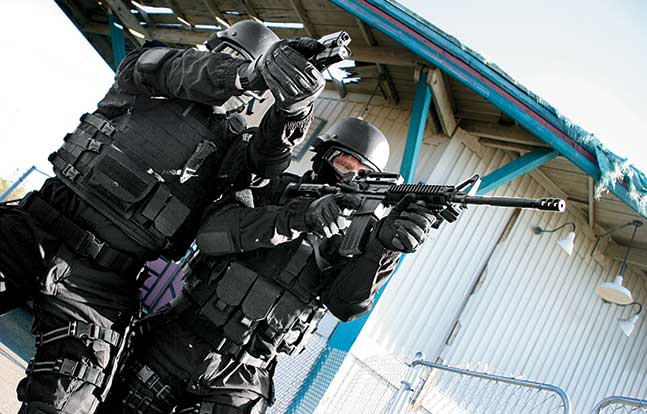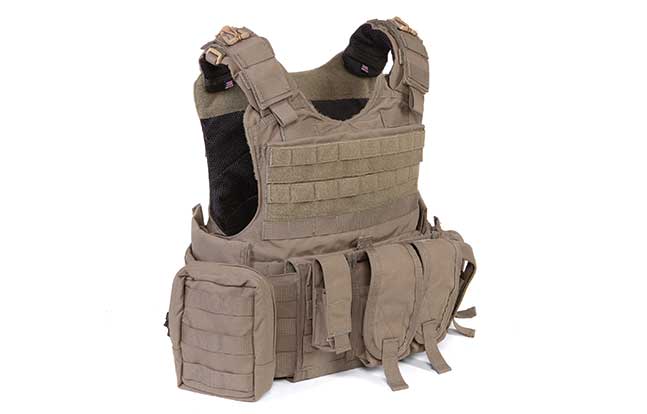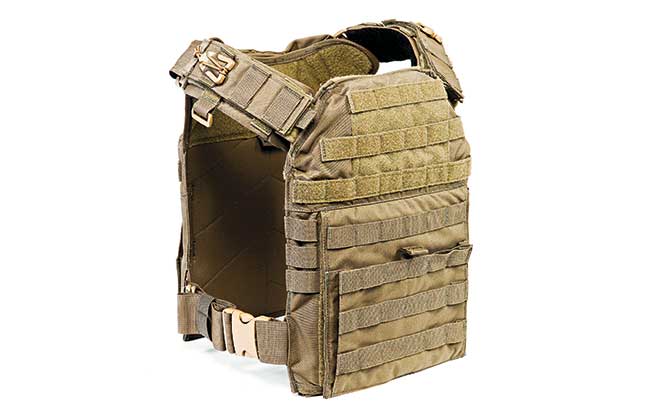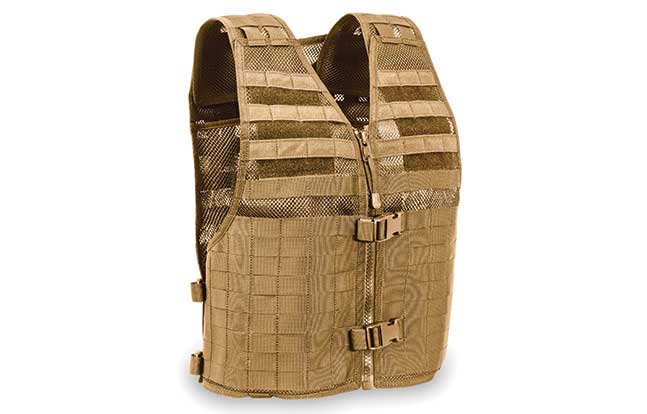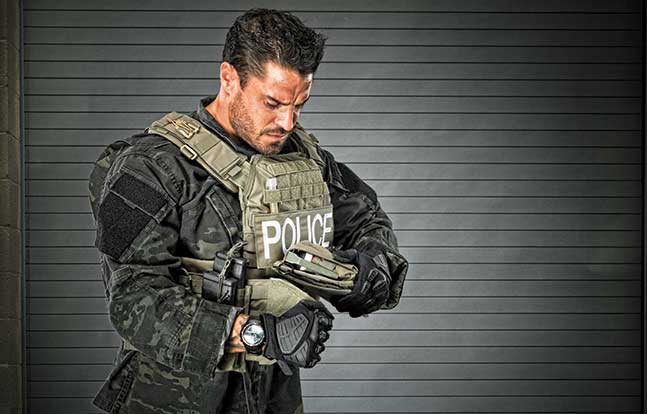Professionals understand the necessity of dressing for success. Deep-sea divers lumber into a complicated wetsuit and helmet. Fighter pilots cinch down straps and buckles of a pressure suit, and the modern badged warrior pulls on body armor at the beginning of every shift. The unique nature of these examples is that they are all designed to keep the professional alive.
Gone are the days of Mayberry, where officers nonchalantly strolled the streets with little more than a duty belt and a cup of coffee. The realities of the world now require that professional officers wear body armor to protect them from potentially lethal gunshot wounds. The last 20 years have seen incredible advancements in body armor technology as well as the gear designed to carry it. From super-light soft armor to plates with exceptional stopping ability, the age of serious body armor has dawned.
Advertisement — Continue Reading Below
The Soft Side
The modern warrior has a spectrum of choices in the body armor arena. There are some guidelines, though, that anyone can follow in deciding what they will need when they armor up. The first is soft armor. Soft armor has been one of the most powerful additions to law enforcement in the last 30 years. It has saved countless lives and is now considered part of the uniform. Soft armor is tested and rated by the National Institute of Justice (NIJ). The NIJ breaks armor down into five categories based on ballistic performance. Essentially they are listed by what rounds they can resist. The categories are: Level I: .22 LR; Level IIA: 9mm to .40 S&W; Level II: 9mm to .357 Magnum; Level IIIA: .357 SIG to .44 Magnum; Level III: 7.62mm rifle rounds; Level IV: Armor-piercing .30-06.
“From super-light soft armor to plates with exceptional stopping ability, the age of serious body armor has dawned.”
Advertisement — Continue Reading Below
The armor works by decelerating the round and forcing it to mushroom out. This keeps the round from penetrating the vest. A byproduct of this action is blunt-force trauma. Those who have survived gunshots because of armor say it is like being hit with a bat. It is important to note that few things are truly “bulletproof.” The armor’s ability to resist bullets is based on the rounds fired and the condition of the vest. The moral of the story is to never get complacent or rely too heavily on equipment.
The level of protection an officer chooses can be influenced by many factors: department policy, cost, weight, etc. As a rule, however, it is highly encouraged that an officer’s armor be rated at a minimum of the rounds issued for their weapon. It is an unfortunate fact that many officers have been shot with their own guns. It is a prudent choice to wear armor that can resist the round that you carry.
Advertisement — Continue Reading Below
Ceramic & Poly Plates
While soft armor is a solid performer at resisting handgun rounds, those who may face rifle threats turn to plates. Armor plates are generally designed to supplement soft armor with a few that can be standalone. As with soft armor, plates are rated for the rounds that they can resist. There are two main categories in plates: Level III, which protect against rifle rounds, and Level IV, which resist armor-piercing rifle rounds.
Plates are constructed from a variety of materials and wrapped in proprietary coverings. The interior material defeats the bullet, and the backing material helps contain it inside the plate. The most common types of plates are ceramic and polyethylene. Ceramic plates have been around since the beginning of serious plate development. They work by fracturing on impact and, in doing so, decelerate the round. The backing material of Kevlar, for example, keeps the round inside the plate. The problem with ceramic armor is that it is both fragile and less effective against multiple rounds. Once the round strikes the plate, a cavitation effect takes place. The result is a cone of plate damage expanding inward from the point of impact. That cone area is now less resistant than it previously was. Because of this fragile nature, I’ve seen plates break from being tossed into cars or the corner of the team room. Even hairline fractures can cause the armor to fail. Weighing in at about 7.5 pounds, a set of ceramic plates can add a very noticeable 15 pounds to an already-heavy rig.
Advertisement — Continue Reading Below
A second type of plate that has caught the attention of the professional community is polyethylene. This is a type of specially designed plastic with the capacity to defeat rifle rounds. Poly armor works differently because it is designed to dramatically expand the incoming round or even break it up while bleeding the energy off. It does this by utilizing the rotation of the round. As the round spins in, it creates friction, which melts a portion of the plate. This melting is one of the unique strengths of poly plates. After the round is captured, the plate cools and seals around the bullet. This allows the plate to be more effective against multiple hits. Companies like Grey Ghost Gear have managed to even create Level IV standalone plates. Coming in at almost 50 percent lighter than ceramic or steel, it has some distinct advantages.
One last plate to mention is steel. While not on the top of elite operators’ loadout lists, correctly coated steel can be a less expensive, reliable alternative.
Advertisement — Continue Reading Below
Picking Carriers
Both soft and plate armor must be worn in quality carriers if they are expected to perform well. Most soft armor companies provide a cotton or polyester carrier with Velcro straps. This is appropriate for officers who need to wear their armor under street clothes. This application is as about as far as it goes for effectiveness, though. More commonly officers are issued or purchase an exterior carrier for their armor. Carriers are essentially broken into two categories: full carriers, which have the capacity to carry both soft and plate armor, and plate carriers.
Multi-load carriers come in a variety of flavors with a spectrum of MOLLE and attachment points for related gear. The buyer should consider what the end use will be and start from there. Will it be a SWAT vest or a patrol vest? Regardless of application, there are certain characteristics that make carriers solid choices. Long-time players in this business like Tactical Tailor make gear designed for serious use without breaking the bank.
Advertisement — Continue Reading Below
Specifically, people should look for certain characteristics. First is multi-stitching on seams and attachment points. This is critical because it ensures durability and can save a life. While drag handles attached on the upper back are helpful if you need to extract a wounded comrade, it should not be the only place to grab the vest. A well-made vest can be grabbed anywhere and survive if a downed officer is dragged to safety.
Another piece of advice is to avoid gear with elastic in the shoulders. Over time the elastic will weaken and your vest will sag. If the vest is not fitted correctly, then you are exposing vulnerable areas.
What about adjustability? From shoulder straps to the cummerbund, the vest needs to be able to be customized to you. A friend or teammate is helpful when you are fitting your vest. They can hold, tighten and square the rig up to help you make sure it is fitted correctly. When it is finally fit to you, the front plate needs to be centered on your torso with the top of the front plate lining up with the top of the sternum. The back plate needs to mirror the front plate.
Advertisement — Continue Reading Below
A popular alternative to an everyday vest is an emergency plate carrier. This configuration has become more common as active-shooter scenarios play out across the country. For operators who do not wear a regular armor loadout, it is a quick alternative. Generally they consist of a ballistic nylon pouch for both front and back plates. The rig is equipped with side snap clips and MOLLE attachment points. One of the leaders in this configuration is U.S. Palm.
Before You Roll
Advertisement — Continue Reading Below
There are some general things to always remember about body armor and carriers. First, the carrier offers no protection at all. Without armor, that well-made carrier becomes an expensive shirt. Keep your armor in the carrier. The only type of armor guaranteed to fail is the one left in the trunk.
It is important to take care of both your carrier and your armor. Follow the manufactures’ instructions to help keep it in good working order. On that note, realize that most armor is only rated to last for five years. This is based on environmental issues, projected wear and tear, and general use. If your armor is ever shot, it must be replaced. The point of impact weakens the armor and could potentially lead it to fail if hit in the same area again. Lastly, body armor is bullet resistant—not knife resistant. If you will be working in an arena where edged weapons are a real issue, you need to acquire stab-resistant armor.
The arena of body armor and carriers is diverse and sometimes confusing. Educate yourself on what your real needs are and dress to meet those needs. Never take shortcuts, and be diligent about wearing your armor. Making an educated decision will allow you to secure a long-lasting, comfortable and effective rig to help keep you alive.
FOR MORE INFORMATION
- BlackHawk: blackhawk.com; 800-379-1732
- Blue Force Gear; blueforcegear.com; 877-430-2583
- Diamondback Tactical; diamondbacktactical.com; 800-882-7667
- Eagle Industries: eagleindustries.com; 888-343-7547
- Elite Survival Systems: elitesurvival.com; 866-340-2778
- Grey Ghost Gear: greyghostgear.com; 877-244-2811
- Point Blank: pointblankenterprises.com; 800-413-5155
- Tactical Tailor: tacticaltailor.com; 866-984-7854
- Uncle Mike’s: unclemikes.com; 800-423-3537
- U.S. Palm: uspalm.com; 480-398-3395
- Voodoo Tactical: voodootactical.com; 877-586-6366
